When it comes to manufacturing precision parts and components, various casting methods have been developed over the years to meet the demands of different industries. One such method that has stood the test of time is A356 Aluminum Casting gravity casting. This simple yet effective technique has been widely used in the automotive, aerospace, and other industries for decades. In this blog, we will explore what aluminum gravity casting is, how it works, and its advantages in today’s manufacturing landscape.
What is Aluminum Gravity Casting?
Aluminum gravity casting, also known as permanent mold casting or gravity die casting, is a metal casting process that involves pouring molten aluminum into a reusable mold to create complex, high-quality parts. Unlike sand casting, which uses sand molds that are destroyed after each use, gravity casting utilizes a permanent mold made from materials like steel or iron. This mold can be used repeatedly, making it a cost-effective and environmentally friendly casting method.
How Does Aluminum Gravity Casting Work?
The aluminum gravity casting process can be broken down into several key steps:
- Mold Preparation: The process begins with the preparation of the permanent mold. The mold is typically made in two halves, which are precision-machined to create the desired part shape. These mold halves are mounted on a casting machine, with one half attached to the stationary side (the “cover die”) and the other to the movable side (the “ejector die”).
- Preheating: To ensure a consistent and defect-free casting, the mold is preheated to a specific temperature before the casting process begins. This helps prevent thermal shock and ensures that the molten aluminum flows smoothly into the mold.
- Pouring: Molten aluminum, usually in the form of an alloy, is heated to its melting point and poured into the mold cavity through a pouring basin or sprue. Gravity facilitates the filling of the mold, hence the name “gravity casting.”
- Solidification: As the aluminum cools and solidifies, it takes on the shape of the mold cavity. This solidification process is carefully controlled to avoid defects such as shrinkage or porosity.
- Ejection: Once the aluminum has fully solidified, the ejector die is used to remove the casting from the mold. The mold can then be prepped for the next casting cycle.
Advantages of Aluminum Gravity Casting
- High Precision: Gravity casting allows for excellent dimensional accuracy and surface finish. The reusable mold halves are precisely machined, resulting in consistently high-quality parts.
- Cost-Effective: Because the molds are reusable, aluminum gravity casting is a cost-effective method for producing large quantities of parts with minimal tooling expenses.
- Reduced Waste: Unlike sand casting, which generates a significant amount of waste in the form of expendable sand molds, gravity casting minimizes waste, making it more environmentally friendly.
- Wide Range of Alloys: Aluminum gravity casting can be used with a variety of aluminum alloys, offering flexibility in material selection to meet specific performance requirements.
- Strength and Durability: Gravity cast parts often exhibit enhanced mechanical properties and better structural integrity compared to parts produced using other casting methods.
- Versatility: This casting method can produce a wide range of part sizes and shapes, making it suitable for a diverse array of applications.
Conclusion
Aluminum gravity casting is a time-tested and reliable method for producing precision aluminum parts and components. Its simplicity, cost-effectiveness, and ability to produce high-quality parts have made it a preferred choice for many industries. As technology continues to advance, it’s likely that aluminum gravity casting will remain an integral part of the manufacturing landscape, contributing to the production of innovative products for years to come.
